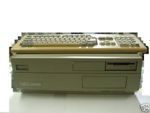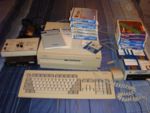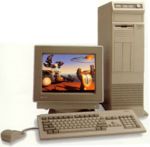Difference between revisions of "Amiga"
(→Amiga 1200) |
(→Amiga 1000) |
||
| Line 16: | Line 16: | ||
I recall that standard Commodore 64/Atari joysticks would work in every model of the Amiga, including the 1000. Typically a mouse is plugged into port 1, and a joystick in port 2. | I recall that standard Commodore 64/Atari joysticks would work in every model of the Amiga, including the 1000. Typically a mouse is plugged into port 1, and a joystick in port 2. | ||
| + | |||
| + | The Amiga 1000 had an expansion slot on the site (the pinout was the reverse from the Amiga 500) allowing the addition of RAM expansion units, and the 'sidecar'. | ||
| + | |||
| + | The sidecar was an interesting periphial, as it was basically a full IBM XT that would use the Amiga for it's keyboard and emulated display (CGA or MGA). The sidecar would typically ship with a 5 1/4" floppy drive, MS-DOS (oem'd to Commodore, naturally), and include some expansion slots, Ram etc. This being a hardware solution would allow the Amiga to run MS-DOS programs, not only at full speed, but in a window, and of course allow the 68000 cpu to do something at the same time. However the sidecars were VERY expensive, about the cost of a comparably configured IBM XT computer. I think it was too small for something like an Intel inboard 386 expansion card, nor did it have space to mount a hard disk. | ||
=== Amiga 500 === | === Amiga 500 === | ||
Revision as of 21:42, 20 September 2009
The Amiga, which was sold by Commodore was one of the most underrated computers of the 1990's.
The amiga was designed by Jay Minor and was originally developed as the Loraine under the brand 'Hitoro'. The Amiga is noted for it's use of the 68000 cpu, and a set of custom coprocessors.
Originally Atari had funded the later stages of the Amiga's development but they had lowballed the final price. HiToro shopped themselves, and Commodore had found an opportunity to snatch the next generation machine from Atari.
Contents
Models
Amiga 1000
The Amiga 1000 was the first model to ship from Commodore. The Amiga 1000 featured a keyboard that could slide under the unit so it wouldn't take up desk space when it was not in use. Also the ports on the back of the Amiga 1000 were all wired BACKWARDS from industry standards as people apparently at the time didn't know if they were allowed to use the standard parallel & serial ports without worrying about a lawsuit. Therefore if you do acquire an Amiga 1000 you'll need special cables if you expect to print from it.
The Amiga 1000 introduced the floppy port that is found in the rest of the Amigas that powers the drive, and automatically sets up it's drive id on the floppy bus.
The Amiga 1000 shipped with 256kb of ram, and an additionally 256kb of ram configured as a "WCS" or writeable control store. Much like how a VAX 11/780 boots, there is enough ROM to read from a secondary storage unit (floppy) where the kickstart OS is loaded into this special WCS to emulate a ROM once it is loaded. At the time of the Amiga 1000's launch it was a rushed product and Commodore felt confident it could just ship updated disks to people, and provide them to dealers etc... All other Amiga's contain their OS in a ROM upgrade, except the Amiga 3000 which used the 68030's MMU to emulate a WCS.
I recall that standard Commodore 64/Atari joysticks would work in every model of the Amiga, including the 1000. Typically a mouse is plugged into port 1, and a joystick in port 2.
The Amiga 1000 had an expansion slot on the site (the pinout was the reverse from the Amiga 500) allowing the addition of RAM expansion units, and the 'sidecar'.
The sidecar was an interesting periphial, as it was basically a full IBM XT that would use the Amiga for it's keyboard and emulated display (CGA or MGA). The sidecar would typically ship with a 5 1/4" floppy drive, MS-DOS (oem'd to Commodore, naturally), and include some expansion slots, Ram etc. This being a hardware solution would allow the Amiga to run MS-DOS programs, not only at full speed, but in a window, and of course allow the 68000 cpu to do something at the same time. However the sidecars were VERY expensive, about the cost of a comparably configured IBM XT computer. I think it was too small for something like an Intel inboard 386 expansion card, nor did it have space to mount a hard disk.
Amiga 500
The Amiga 500 was a Commodore 64 style influenced Amiga. It included 512kb of system ram, and a single floppy drive built in. The chipset used in the Amiga 500 would be known as the 'OCS'. It also featured a single expansion slot on the left side, that could allow accelerators, hard disks, scsi ports (etc) to be added to the system in a 'side car' like expansion.
This was perhaps one of the most popular models of the Amiga, and was very popular in the 1980's.
Amiga 600
This should have been a low cost version of the 500, with the updated ECS chipset, however it wound up costing more then the Amiga 500. This was to replace the 500, at the time of the 1200's release. One of the big differences in the Amiga 600 was the move to all surface mount chips that would increase the reliability of the boards. However this also meant it was extremely difficult to repair the boards as none of the chips were socketed. The Amiga 600 also included a PCMCIA slot, and an IDE controller. However the software to boot from the IDE interface was NOT included in the default ROMS that shipped with the Amiga 600.
Amiga 1200
The Amiga 1200 used a 68020 cpu, and the new AGA chipset that also shipped in the Amiga 4000. It also was a single 'wedge' like the Amiga 600/500.
The Amiga 1200 used surface mount chips, much like the Amiga 600, and it too also had a PCMCIA slot, and a IDE controller port along with the mounting space for a 2.5" IDE disk.
There were upgrade modules to expand the 1200 up to a 68060, and some PowerPC modules as well.
Amiga 1500
This Amiga was a desktop model that did NOT include any ISA slots preventing the bridgeboard upgrade. Otherwise it's identical in specs to the Amiga 2000.
Amiga 2000
The Amiga 2000 was a desktop version of the Amiga 500. It featured Zoro expansion slots, the same 68000 cpu, and 1mb of ram as standard. The 2000 also included some 16bit and 8bit ISA slots allowing a bridgeboard card for IBM XT/AT emulation, and the ability to use IBM PC cards.
Amiga 2000HD
The Amiga 2000HD was a Amiga 2000 that included a hard disk that had been installed at the factory. Otherwise it was the same as an Amiga 2000.
Amiga 2500
I recall this Amiga being an Amiga 2500HD with a 68020 accelerator pre-installed from the factory. Otherwise it was an upgraded 2000.
Amiga 3000
The Amiga 3000 was a 68030 Amiga that used the ECS chipset, and was fully 32bit. The Amiga 3000 used ZIP ram instead of DIP, at the time allowing for faster memory access. However the industry at large would shun the ZIP chip, and instead move to the SIMM. This is a MAJOR obstical for anyone trying to upgrade an Amiga 3000 today.
Another thing worth noting is that the first Amiga 3000's shipped before the OS was ready. They have a beta version of the unrelease 1.4 in ROM. It is used primarily for loading either a patched version of 1.3 or 2.0 from the hard disk. As the os wasn't quite ready, Commodore shipped a number of upgrades on floppy that would replace the kickstart files that were on a separate partition on the hard disk.
Amiga 3000UX
The 3000UX was an Amiga 3000 that included a SCSI tape drive, and came with Commodore's SYSVr4 port. This model could have saved the company as SUN wanted to rebrand the machine, and make MILLIONS with it. Naturally Commodore declined such a deal. It is worth noting that Commodore UNIX could run on any other Amiga 3000, and there are some 'hacks' to copy the tape image onto a second hard disk, and allow install without requiring the tape, or the tape drive.
Amiga 3000T
The Amiga 3000T was basically the same as the Amiga 3000, however it was in a Tower case, giving more room for disk drives, and expansion slots.
This is a very RARE model.
Amiga 4000
The Amiga 4000 was based around the 68040 cpu, and the AGA chipset. This was the desktop model.
Amiga 4000T
The Amiga 4000T was in the same idea as the 3000T. This was just an Amiga 4000 in a tower case. Commodore went bankrupt shortly after the introduction of the Amiga 4000T. Like the 3000T these are very rare to find.
The chipsets
These chips were to offload as much of the IO from the main 68000 as possible freeing it for cpu only work. It was a novel idea at the time as most machines only had room for a floating point (math) coprocessor, such as an 8087, or 688881. The chips include:
OCS
ECS
AGA
The Operating System
AmigaDOS was a port of TripOS to the 68000 cpu. The GUI intuition ran ontop of it.







